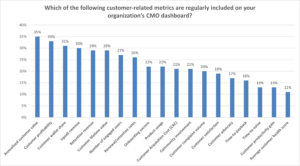Great Balls Of Fire! Customer Engagement Is On Your CMO’s Radar
The release of Top Gun: Maverick in May was big news at my house. If you’re still mooning over the 1986 original, you remember the unrestrained bravado of “I’ve got tone!” when a pilot locked on an enemy aircraft.
Customer Marketers: You’ve Got Tone
Customer marketing is gaining more attention as organizations recognize the importance of delivering value, building loyalty, understanding voice of the customer, and creating advocates. These are table stakes for keeping and expanding accounts.
- Forrester research shows that 60% of B2B marketing organizations plan to increase spending on customer engagement.
- Forrester’s The State Of Customer Obsession 2021 survey shows that organizations that put customers at the center of leadership, strategy, and operations outperform their non-customer-obsessed peers.
- High-growth companies ranked “focus on postsale customer engagement” as the fourth most important priority to the organization’s marketing strategy over the next 12 months, according to Forrester’s 2022 Global Marketing Survey.
With that validation, now is the time for customer marketers to demonstrate your crucial role.
Focus On Outputs You Control
It’s customer marketing’s job to track and report on value to the business. That can feel like an impossible mission. You might not have received a lot of guidance from leadership on this, especially if your organization isn’t mature in its approach to postsale engagement.
At Forrester’s B2B Summit, Brett Kahnke and I discussed the importance of connecting customer marketing activity, the actions that keep you busy and make you feel productive, to shared impact metrics such as retention, efficiency, and growth. The key is to stake out the middle ground between actions and impact. This middle ground is output metrics — the results of your actions. You can find more details in our newly published Dashboard Guidelines: Customer Marketing.
You should begin by understanding what matters to the company. Reputation? New business growth? Growth from the customer base? Efficiency? Then show how your outputs, such as driving faster adoption, streamlining and scaling customer storytelling, and influencing upsell opportunities, contribute to those shared, high-level metrics.
In our day-to-day work with customer marketers, we see that those who can establish and reinforce outputs related to shared impact metrics are better able to gain and keep the attention of leaders. By contrast, it’s frustrating to try to connect tactics and actions such as email opens and number of case studies directly to impact metrics. It’s a much bigger, and less credible, leap.
Your CMO Wants To Know
Our Global Marketing Survey of B2B marketing decision-makers shows that customer engagement output metrics are becoming more prevalent on CMO dashboards. Between our 2021 and 2022 surveys, the presence of “community involvement” as a metric reported on CMO dashboards rose 62%, from 13% of respondents indicating it was on their CMO dashboard in 2021 to 21% in 2022. The rising importance of community in its many forms reflects the ongoing shift to delivering robust value in the postsale journey, not just through the offering but through engagement with peers, partners, and employees.
Additional metrics on CMO dashboards include product usage, number of engaged users, and advocacy participation. All of these output metrics reflect the customer marketing remit of loyalty, adoption, and advocacy (see Figure 1).
The lesson for customer marketers: Our research shows that CMOs are paying attention to engagement metrics. Feel the need for speed and seize the opportunity to show your meaningful contribution.
Fig 1: CMO Dashboard Metrics

